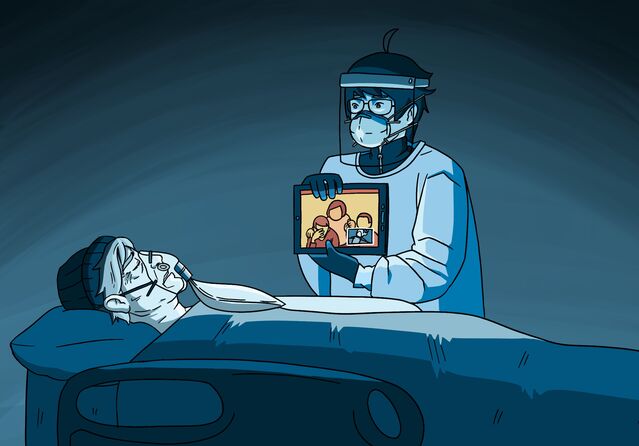Coronavirus Disease 2019
How COVID-19 Twisted Death and Grief
Long after the pandemic, we will continue to grapple with our collective losses.
Posted January 2, 2021 Reviewed by Lybi Ma

Even before the COVID-19 pandemic, dying in the United States was already a fraught experience. About seven in ten Americans expressed that they wanted to die at home, yet only 30 percent managed to do so.
Unfortunately, COVID-19 has further warped how we die.
Dr. Hedieh Matinrad is a chief resident at the Santa Clara Valley Medical Center and an incoming palliative medicine fellow at the University of California, San Francisco. According to Dr. Matinrad, prior to the pandemic, "family members could see their loved ones in the hospital through the course of hospitalization, be with them as the illness progressed over days to weeks to the end of life."
COVID-19, however, forced hospitals into a vexing moral calculus—one that pits the desires of dying patients and their families against a duty to minimize the spread of the pandemic. This led to stark restrictions in visitor policies in health care facilities, with even more stringent rules for patients stricken with COVID-19.
My hospital gave family members of dying COVID-19 patients the option of watching their loved ones through a small window. However, the visitors would not be able to hold and comfort the patients in their last moments, which, according to Dr. Matinrad, is “when a person with serious illness often seeks solace and comfort from a familiar face and voice.” Under normal circumstances, these ostensible acts of mercy would have seemed indistinguishable from cruelty.
But these were not normal times. If a patient's relatives could not come into the hospital, we would have only one tool left at our disposal: The iPad. These tablets gave many patients a last, tenuous lifeline to their loved ones before they lost their ability to say goodbye. Still, technology could provide only a pale imitation of a good death.
Ever since I began taking care of patients with COVID-19—and, by extension, losing them—I've spent countless nights imagining how my patients must have felt in their final days. What did they think of their caretakers, ensconced in our face shields, N95 respirators, contact gowns, and nitrile gloves—fully insulated from their touch?
Despite our best efforts, they must have felt very, very lonely.
As a junior doctor learning to bear the responsibilities of my profession, I've been reminded by other, more seasoned physicians that death is a problem for the living. Every patient who dies of COVID-19, according to a recent study, will leave behind nine bereaved family members. By the time that this post is published, approximately 350,000 Americans will have died from the pandemic, meaning that 3,150,000 people will be grieving their deaths.
And yet, this number severely underestimates the scope of heartaches caused by COVID-19, as it does not account for friends, neighbors, and other positive relationships forged in one's lifetime. The number also does not include individuals who did not die of the virus but whose end-of-life experiences were indelibly affected by the pandemic through visitor restrictions and social distancing rules. When the pandemic made funerals, religious services, and other large gatherings untenable, it also stole our ability to properly mourn the victims of the pandemic together.
While the dead cannot suffer anymore, their loved ones will continue to grapple with their losses, long after COVID-19 has settled into the pages of history. Right now, we may be busy tending to the dying, but eventually, the living must also have the chance to heal.
References
Cross, Sarah H., and Haider J. Warraich. 2019. “Changes in the Place of Death in the United States.” The New England Journal of Medicine 381 (24): 2369–70.
Verdery, Ashton M., Emily Smith-Greenaway, Rachel Margolis, and Jonathan Daw. 2020. “Tracking the Reach of COVID-19 Kin Loss with a Bereavement Multiplier Applied to the United States.” Proceedings of the National Academy of Sciences of the United States of America 117 (30): 17695–701.
“Views and Experiences with End-of-Life Medical Care in the U.s. - Findings.” 2017. April 27, 2017. https://www.kff.org/report-section/views-and-experiences-with-end-of-li….


